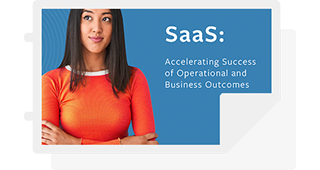The use of cloud computing platforms has seen a significant rise in modern application development, with cloud infrastructure configuration accounting for up to 33% of global IT spending between 2017-2018. So, let’s ask the question: five years later, what is the state of the cloud?
Let’s take a look!
State of cloud computing today
As with all new technologies, the cloud wasn’t adopted and implemented overnight. It took time for people to grasp what the cloud was—and even more time for tech companies to build out the infrastructure and technologies that would support the cloud. Taking it from a concept to a fully realized business offering is no small task.
(See how emerging technology cycles through hype.)
In the modern IT landscape, cloud computing has been gaining steady adoption due to its numerous benefits—like agility, scalability, and high performance.
By allowing resource provisioning in response to changes in workload requirements, cloud computing lets organizations configure flexible architecture to handle dynamic applications. Cloud platforms also enable:
- Rapid product testing and delivery
- Elastic global scaling
- Better overall application performance
- Developer productivity
Today, organizations around the world have harnessed cloud computing technology to provide a massive and diverse array of service offerings. Enterprises are increasingly adopting cloud computing services:
- 92% of enterprises surveyed already embrace a multi-cloud strategy.
- 83% have used the hybrid cloud strategy.
Enterprises continue to accelerate public cloud adoption, with 36% of organizations spending over $12 million per year on public clouds.
It’s clear that the cloud has become a technology that organizations can’t afford to ignore. Making the most of the cloud is no simple task, but many organizations are finding ways to optimize their cloud spend without decimating their budgets. The massive array of offerings leveraging the power of the cloud continues to grow as more businesses experiment with the new technology, finding ways to maximize its potential.
Cloud computing trends 2022
Here are today’s emerging trends—see how they highlight the prominence of cloud computing in today’s rapidly changing tech landscape.
- Multi- and/or hybrid cloud environments. An increasingly popular choice, that is being adopted by organizations to support workloads that require a vendor-agnostic, multi-platform approach.
- Edge computing. A decentralization trend in which compute and storage elements are deployed closer to the devices for reduced latency and bandwidth optimization.
- Serverless computing. This computing model involves several levels of backend-as-a-service offerings that let developers code freely while cloud providers manage platform implementation.
- Data democratization. A system that allows user to access, explore and analyze data to aid in decision-making for data-driven applications
(Explore cloud growth, stats & more.)
Cloud computing concepts
Use cases of the cloud are extensive, as it is used across a wide spectrum of individual users, private organizations, and federal alike. The basic foundation of cloud computing is that the intricacies of infrastructure implementation and the service location are hidden from the end-user.
- For individuals, the cloud allows users to access information or SaaS-based applications from any device connected to the internet without the fear of local loss of data or the requirement of installation and regular updating.
- While for organizations, cloud computing offers an agile and highly scalable platform to host applications and offer services.
While use cases differ, the following section explores how a typical cloud computing framework functions, and different cloud-based models available to organizations solving varying purposes.
How cloud computing works
Most trends in modern application development, such as containers and CI/CD pipelines are considerable factors that are pushing organizations to adopt the cloud. While there’s no denying that the cloud has become a major part of IT infrastructure for the majority of companies, it can be difficult to understand what exactly this means from an operational perspective.
With cloud computing, an application’s backend—the primary group of computing components responsible for storing and processing data—is hosted on remote servers. These servers are exposed to the internet through pre-defined rule sets known as protocols.
The users then access the application through the front end: a browser or application endpoint with permissions to communicate with the server. The cloud service provider, managed either in-house or by an external third party vendor, manages the infrastructure required to run the server and related components, so that the application’s users only have to connect with its services using an internet connection.
(Read about cloud infrastructure.)
Types of cloud computing offerings
A typical application delivery contains numerous components requiring provisioning, configuration, and management effort. To help with this, cloud-based services are offered through different business models that are focused on a specific component as the primary offering.
Let’s look at the most common three—IaaS, PaaS, and SaaS.
(Looking for more? Read our in-depth explainer on all three.)
Infrastructure-as-a-Service (IaaS)
In an IaaS offering, the cloud service provider manages the basic IT infrastructure such as servers, storage, and networking. This allows the ‘user organization’ to leverage the offered infrastructure and configure the platform of its choice for hosting applications. Features of an IaaS offering include:
- Allows to provision development, staging, and test environments as required
- Enables application hosting with on-demand scalability
- Offers pre-configured data storage, backup, and recovery
- Supports on-demand computing for high-throughput requirements such as big data, machine learning, and other complex simulations
Platform-as-a-Service (PaaS)
Beyond abstracting the physical computing infrastructure, PaaS cloud offerings provide a dynamic, on-demand platform that supports application delivery, deployment, management, or testing. This allows developer organizations to quickly develop code and deploy it to production without having to worry about managing infrastructure or setting up deployment environments.
Software-as-a-Service (SaaS)
By far the most common offering, SaaS delivers entire applications over the internet on a subscription basis. In such offerings, the cloud provider will:
- Host the application code and the underlying infrastructure.
- Handle all aspects of its maintenance as per a mutual service level agreement (SLA).
Individual users can then access the software service through an endpoint such as an application or browser. Some commonly known SaaS applications include Google Workspace, Netflix, Dropbox, and YouTube.
(Check out the latest SaaS trends & news.)
Cloud computing deployment strategies
With a steady adoption rate, several types of cloud computing strategies have evolved to meet the needs of different use cases. There are three common approaches to provision a cloud infrastructure.
(Explore public, private & hybrid cloud use cases.)
Public cloud
Considered one of the most popular deployment strategies on account of its ease of management and cost benefits. In a public cloud, third-party service providers own and operate data centers while delivering computing resources over the internet. Popular public cloud platforms include:
- Amazon Web Services (AWS)
- Microsoft Azure
- Google Cloud Platform (GCP)
Private cloud
A single organization purchases/configures data center resources to be managed and maintained on private networks. Private clouds can either be:
- Physically hosted on self-managed data centers
- Remote servers managed by third-party service providers
Though the efforts and cost towards managing a private cloud are considerably higher than a public cloud, organizations that deal with sensitive data or niche domains that cannot avail a third-party service commonly opt for a private cloud deployment model.
Hybrid/multi-cloud
Automation and orchestration technologies are used to bind together public and private clouds deployment models for the sharing of data and applications. Businesses typically use hybrid clouds to improve flexibility, access more deployment options, enforce security and compliance, and optimize existing infrastructure.
Benefits of shifting workloads to the cloud
Though use cases differ for different organizations, following are some of the most commonly known benefits of adopting a cloud service:
- Cost optimization. With cloud computing, organizations eliminate the capital expenses of purchasing and configuring computing infrastructure, the personnel and costs of running on-premises data centers.
- Speed. Cloud computing platforms offer services on-demand, allowing services to be deployed and applications to access production scale resources within minutes of deployment.
- Scalability. The ability to scale up resource capacity rapidly is one of the prime benefits of leveraging the cloud. This allows an organization to provision resources based on demand spikes while keeping operating expenses low.
- Enhanced application performance. By deploying services on globally distributed Content Distribution Networks (CDNs) and efficient load balancing mechanisms, a cloud deployment enables high availability and workload performance.
- Reliability. Cloud computing also simplify data backup and disaster recovery, thereby assuring business continuity. Additionally, by leveraging innovative monitoring and storage strategies, cloud-based stateful workloads are considered much more resilient and reliable than those running on a monolith framework.
(Understand the effect of redundancy on availability.)







